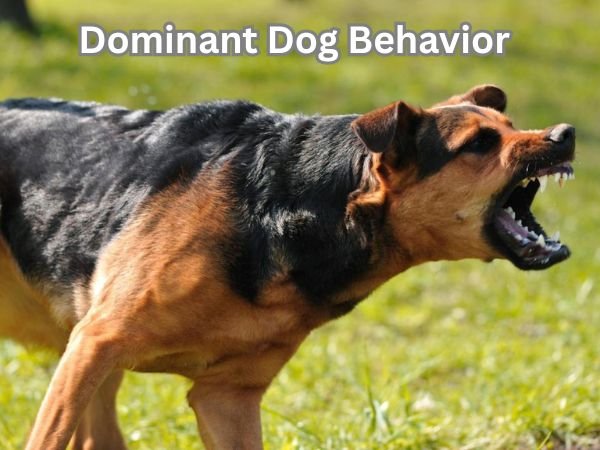
Dominant dog behavior is a natural part of how dogs communicate and establish social order within their canine hierarchy. It involves behaviors that show a dog’s desire to take charge or lead, which can sometimes be misunderstood by owners. Understanding dominant dog behavior is important for anyone who wants to create a peaceful and respectful home environment where both dog and owner thrive. By learning to recognize these behaviors and applying positive dog training techniques, owners can manage dominance in a way that fosters trust and cooperation rather than conflict.
This article will explore six positive training secrets designed to help you guide your dominant dog toward better behavior and a stronger bond with you.
What Is Dominant Dog Behavior? Signs and Myths
Understanding dominance in dogs can help you build a healthier relationship with your pet. It’s important to know what dominance really means and how it shows up in your dog’s behavior.
What Does Dominance Mean in Dogs?
Dominance is about your dog trying to take a leadership role. It’s different from aggression. While aggression is about fear or defense, dominance is about control and influence in social interactions. A dominant dog isn’t necessarily bad or aggressive; it’s just trying to set rules in its world.
Common Signs of Dominant Behavior
Look out for these behaviors, which may indicate dominance:
- Resource Guarding: Protecting toys, food, or spaces from people or other pets.
- Body Language: Standing tall, direct eye contact, stiff posture.
- Refusing Commands: Ignoring your requests or instructions.
- Space Invasion: Getting too close or ignoring your personal space.
- Persistent Mounting: Repeatedly mounting other dogs or even people.
Common Myths About Dominance
There are many misunderstandings about dominance in dogs:
- Dominance does not mean your dog is “bad.”
- Not all “misbehaviors” are signs of dominance. Sometimes dogs just need training or mental stimulation.
- Dominance aggression is a term used when dominance leads to aggressive actions, but it’s not the same as simple dominant behavior.
By recognizing these signs and myths, you can better understand your dog’s needs and guide them calmly and confidently toward good behavior. Leadership in dogs is about trust and respect, not fear or force.
Why Do Dogs Exhibit Dominant Behavior?
Dominant Dog Behavior-Dogs show dominant behavior for various reasons. Understanding these can help you better manage and bond with your furry friend.
Causes of Dominant Behavior
- Genetics: Some breeds have a natural tendency to be more assertive.
- Socialization: Dogs not well-socialized may show dominance to assert control.
- Environment: Stressful or crowded surroundings can trigger dominant acts.
- Training Inconsistencies: Mixed signals from owners can confuse dogs about their place in the family.
- Age: Younger dogs often test boundaries, while older dogs may become dominant if not guided.
- Sex: Male dogs are sometimes more prone to dominance due to instincts.
- Breed: Working or guarding breeds often display dominant traits.
Understanding Canine Personality and Pack Dynamics
Dogs have unique personalities, just like people. Some are naturally more confident and assertive. In the wild, dogs live in packs with a clear dominance hierarchy led by a pack leader. This natural instinct influences their behavior at home, where they may try to establish themselves as the leader.
Tips for Managing Dominant Behavior
- Consistent Training: Use clear, calm commands and reward good behavior.
- Proper Socialization: Expose your dog to different people and settings from an early age.
- Set Boundaries: Be consistent with rules and expectations.
- Observe Body Language: Understand when your dog is trying to assert dominance and redirect gently.
When Does Dominant Behavior Cause Dog Behavior Problems?
Dominance becomes an issue when it leads to aggression, disobedience, or anxiety. If your dog challenges your authority, it might be trying to become the pack leader, which can cause conflicts.
Remember, dominant behavior is normal but manageable. With patience, training, and love, you can help your dog feel secure and happy in their place within your family.
If you face ongoing challenges, seeking advice from a professional trainer experienced in dominance and pack dynamics can make a big difference.
Dominant Dog Behavior: The Risks of Unmanaged Dominance
Dominant Dog Behavior- Understanding dominant behavior in dogs is important for every pet owner. When a dog’s dominant attitudes go unmanaged, it can lead to problems that affect everyone in the household.
What Can Happen If Dominance Is Ignored?
- Increased Aggression: A dominant dog may become aggressive toward family members or other pets. This can result in growling, biting, or fights.
- Household Stress: Tension builds when a dog tries to control spaces, resources, or people. It makes home life uncomfortable for everyone.
- Potential Injuries: Conflicts caused by dominance can cause physical harm to dogs or family members.
Resource Guarding and Territoriality
Dominant dogs often guard their food, toys, or resting places. They may also be territorial, protecting areas of the home from others. This behavior can cause stress and aggression unless carefully managed.
Safety Tips for Dog Owners
- Supervise interactions between pets closely.
- Avoid encouraging guarding behaviors by not disturbing your dog when eating or resting.
- Use positive reinforcement to reward calm behavior.
- Seek training advice early if you notice signs of dominance problems.
By recognizing and managing dominant behavior, you protect your pets and family while creating a happier home for everyone.
6 Positive Training Secrets for Dominant Dogs
1.Establish Clear Boundaries and Rules
Creating clear boundaries is key when managing dominant dog behavior. Dogs feel more secure and behave better when they understand their limits in the home.
Consistency in Commands
- Use the same words and tone for commands every time to avoid confusion.
- Keep commands simple and clear, like “sit,” “stay,” and “off.”
- Practice commands regularly to reinforce them.
Furniture Rules
- Decide if your dog is allowed on furniture and be consistent.
- If furniture is off-limits, gently but firmly guide your dog off every time they climb up.
- Provide a comfy alternative like a dog bed for them.
Feeding Times
- Feed your dog at the same time each day to create a routine.
- Avoid free-feeding; having set meal times gives structure.
- Use feeding time as an opportunity to reinforce calm, respectful behavior.
By setting these consistent rules, you show your dog that you are the leader, which helps reduce dominant behaviors and builds a peaceful relationship.
2.Reward Calm and Compliant Behaviors
When it comes to dominant dog behavior, one of the best ways to encourage good manners is through positive reinforcement. Rewarding your dog for calm and obedient responses helps build trust and keeps your relationship happy and healthy.
Why Reward Calmness?
Dogs naturally look for guidance, and when they get rewarded for being calm, they learn that relaxed behavior brings good things. This can reduce aggressive or pushy actions.
How to Reward Calm and Compliant Behaviors
- Use Treats: Give small, tasty treats when your dog listens or stays calm in exciting situations.
- Offer Praise: Use a happy tone to say “Good job!” or “Well done!” right after the calm behavior.
- Gentle Petting: Soft scratches or belly rubs can be a great reward for good behavior.
- Consistency: Always reward calmness, so your dog knows what to expect.
- Timing: Give the reward immediately after the behavior to help your dog connect actions with outcomes.
Remember, rewarding calm and obedient behavior isn’t just about training—it’s about deepening your bond. Celebrate those good moments, and your dog will feel loved and motivated to keep being their best self.
3.Dominant Dog Behavior
Understanding and managing dominant behavior in dogs starts with meeting their physical and mental needs. When dogs feel satisfied and engaged, they are less likely to act out in ways that seem bossy or challenging.
Meet Your Dog’s Physical Needs
- Daily exercise is a must
A tired dog is a happy dog. Regular walks, playtime, or runs help them burn off energy. This reduces restlessness and frustration, which can fuel dominance. - Keep it consistent
Try to stick to a daily routine. Dogs feel more secure when they know what to expect.
Meet Your Dog’s Mental Needs
- Enrichment activities are key
Puzzle toys, training sessions, or games like hide-and-seek keep their minds busy. Mental stimulation prevents boredom, a common trigger for dominant behavior. - Change it up often
Variety sparks interest and keeps your dog from feeling stuck or bored.
Avoid Boredom-Induced Dominance
- Boredom can lead to attention-seeking and testing boundaries.
- Provide plenty of outlets for energy and curiosity.
- Spend quality time bonding through play and gentle training.
Remember, a well-exercised and mentally challenged dog is more relaxed and cooperative, making dominance issues easier to manage. Creating a balanced routine helps your dog feel secure and loved.
4.Teach Impulse Control and Patience
Helping your dog learn impulse control and patience is key to good behavior and a happy relationship. Simple commands like “wait,” “sit-stay,” and controlled greetings can make a big difference.
Why It Matters
Dogs that can control their impulses are calmer, safer, and more enjoyable to be around. Teaching these skills builds trust and shows your dog how to act in different situations.
Techniques to Try
- Wait: Before giving your dog food or letting them out the door, ask them to wait. Start with just a few seconds, then gradually increase the time.
- Sit-Stay: Use this command to teach your dog to stay in one place calmly. It’s great for busy moments like mealtime or before walks.
- Controlled Greetings: If your dog gets excited when meeting people, practice having them sit and wait before saying hello. This slows things down and keeps your dog polite.
Tips for Success
- Be consistent with your commands and rewards.
- Use treats or praise to motivate your dog.
- Keep training sessions short and fun—a few minutes at a time.
- Stay patient; learning takes time for your dog.
By practicing these simple steps, you help your dog become more disciplined and patient, making life together smoother and more enjoyable.
5.Ignore Demanding Behaviors, Reward Polite Ones
When your dog acts pushy or demanding, avoid giving in or reinforcing that behavior. For example, if your dog repeatedly nudges you for attention or drops a toy in your lap to start play, don’t immediately respond. Instead, wait until your dog is calm and polite before giving attention or treats.
Here’s how to manage this effectively:
- Ignore pushy actions: If your dog barks, paws, or nudges for attention, turn away or gently redirect without reacting.
- Reward polite behavior: Praise or give treats when your dog sits calmly, waits patiently, or comes quietly for attention.
- Be consistent: Everyone in the household should respond the same way to demanding behaviors to avoid confusing your dog.
- Set clear boundaries: Use commands like “sit” or “wait” and reward compliance to encourage good manners.
- Stay patient: Changing behavior takes time, so be steady and kind.
By ignoring demanding behaviors and rewarding polite ones, you teach your dog that calm and respectful actions get the best results. This approach helps build a positive, trusting relationship and reduces frustration for both of you.
6.Dominant Dog Behavior: Socialization and Exposure to New Situations
When dealing with dominant dog behavior, socialization and gradually exposing your dog to new people, pets, and environments is key. This helps your dog feel more secure and balanced, reducing the chances of unwanted dominant actions.
Why Socialization Matters
- Helps your dog learn how to interact politely with others.
- Builds confidence in new settings.
- Reduces fear or anxiety that can trigger dominance.
How to Introduce New Experiences Gradually
- Start with calm, friendly people your dog can meet in a relaxed setting.
- Introduce other dogs slowly, watching for signs of stress or aggression.
- Visit new places together, like parks or pet stores, without rushing.
- If needed, seek help from a professional trainer who understands dominant behaviors.
By taking small steps, your dog will learn the right way to behave and enjoy new experiences without feeling the need to control the situation. Remember, patience and gentle guidance go a long way!
When to Seek Professional Help for Dominant Dog Behavior
Dominant behavior in dogs can sometimes be part of their natural instincts, but when it crosses certain lines, it’s important to get help. Knowing when to reach out to a professional can keep both you and your dog safe and happy.
Warning Signs That Require Intervention
- Aggression towards people or other dogs: Growling, snapping, or biting that feels intense or sudden.
- Protectiveness over food or toys: If your dog snaps or stiffens up when you approach during meals or playtime.
- Refusal to obey basic commands: Especially if your dog ignores you or challenges your authority regularly.
- Excessive mounting or mounting objects/people: This can be a sign of trying to assert dominance.
- Destructive behavior or intense guarding: When your dog becomes possessive over certain spaces or items.
If any of these signs sound familiar, it’s time to get help!
Why Safety Matters
Dominant behavior can quickly turn dangerous if not handled right. The safety of you, your family, and your dog should always come first. Avoid punishing your dog harshly, as this may make problems worse.
The Value of Certified Trainers and Veterinarians
- Certified trainers: These professionals understand dog psychology and can create a training plan tailored to your dog’s needs.
- Veterinarians: Sometimes, behavior issues can stem from health problems. A vet can identify these and recommend the best treatment.
- Behaviorists: Experts who specialize in solving complex dog behavior challenges and helping dogs become more balanced and confident.
Getting help from certified professionals not only improves your dog’s behavior but also strengthens your bond with them.
Remember, seeking help early can prevent problems from escalating and ensure a happier life for you and your furry friend!
Conclusion
Building a Respectful Relationship with Your Dominant Dog
Positive training is key to managing dominant dog behavior. When you use gentle, consistent training methods, you build trust and respect with your dog rather than fear or aggression. This helps your dog feel secure and eager to follow your guidance, which makes life easier and more enjoyable for both of you.
FAQ
Does dominance mean my dog wants to be the “alpha”?
No, dominance doesn’t mean your dog wants to be the alpha. It usually means your dog is confused or unsure. Dogs don’t try to control people—they just need clear rules and calm guidance.
Can dominance be changed with training?
Yes, dominant behavior can improve with consistent, positive training. Teaching basic commands, rewarding calm behavior, and setting clear boundaries help your dog feel secure and follow your lead.
Should dominant dogs be punished?
No, punishment can make things worse. Instead, use calm leadership, reward good behavior, and redirect bad habits. Positive training builds trust and better results.
What’s the difference between dominance and aggression?
Dominance is about control or pushy behavior, while aggression is fear or defense-based. Not all dominant dogs are aggressive, and not all aggressive dogs are dominant.
When should I consult a professional dog trainer or behaviorist?
Call a pro if your dog shows signs like growling, biting, or guarding space. A certified trainer can safely guide you and your dog with a custom plan.




